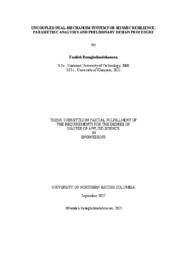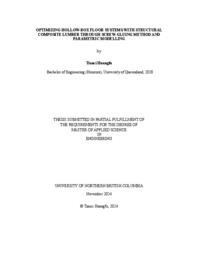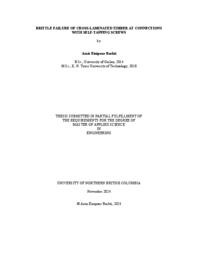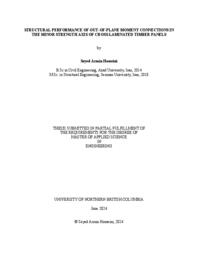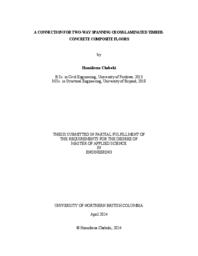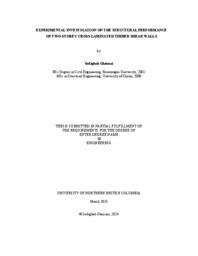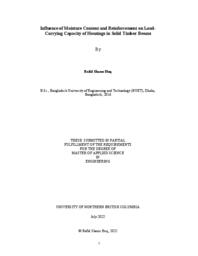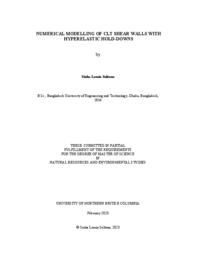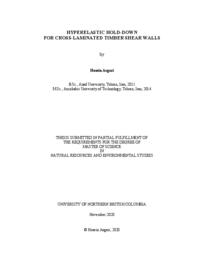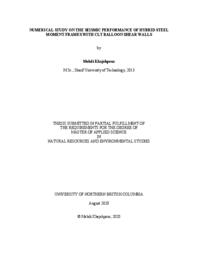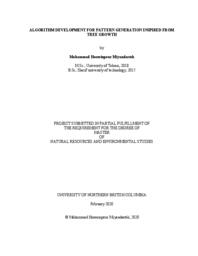Tannert, Thomas
Person Preferred Name
Thomas Tannert
Related Works
Content type
Digital Document
Origin Information
Content type
Digital Document
Origin Information
Content type
Digital Document
Origin Information
Content type
Digital Document
Origin Information
Content type
Digital Document
Origin Information
Content type
Digital Document
Description / Synopsis
Cross-laminated timber (CLT)-concrete composite (CLTCC) floors have gained popularity in recent years due to their advantages over pure wood floors. They offer a high loadcarrying capacity, increased stiffness, improved fire resistance, vibration performance, sound insulation, and thermal mass, making them suitable for floor applications with long spans and twoway spans. However, to fully utilize the two-way spanning capacity of CLTCC floors, the minor strength axis panel-to-panel edge connections need to withstand out-of-plane bending for composite action. In this study, experimental and numerical investigations were conducted to investigate the use of steel kerf plates (K connection) and steel T-bars (T connection) as edge moment and shear connectors in CLTCC floors. The kerf plates were embedded in 139-mm-thick five-layer CLT panels to a depth of 35 mm, and T-bars were mounted with self-tapping screws to connect two CLT panels of 600 mm length from the top and LVL spline from the bottom. T-bars were connected to CLT by screws in the shear zone as shear connectors. A total of 30 test specimens were subjected to shear forces and bending moments to evaluate load-carrying capacity, rotational and bending stiffness. In the shear tests, the T connection exhibited a shear connection stiffness approximately twice that of the K connection in the minor direction, with a 46% greater load-carrying capacity. The T connection in both directions could provide the two-way composite action required in the CLTCC slab. However, the T connection serviceability stiffness in the minor direction was approximately 40% lower than that in the major direction. The bending tests demonstrated that the combination of T connection and LVL spline effectively reached the rotational and bending stiffness, as well as the loadcarrying capacity, of a continuous CLT panel with the same layup. While T and K connections achieved similar load-carrying capacity, the bending stiffness with the K connection was only half of that with the T connection. In addition, the rotational stiffness with the T connection was approximately 1.6 times greater than that of the K connection. The composite efficiency was 56% for the T connection and 7% for the K connection, demonstrating that the T connection provides composite behavior in the minor strength axis. In the numerical investigation, a sensitivity analysis was conducted to assess the factors impacting the bending capacity and deformations of CLT and CLTCC slabs interconnected by T connections including biaxial connection stiffnesses between two layers and rotational stiffness between two panels. Subsequently, a 9×12 m CLTCC slab with T connections was designed and modeled. The two-way action was predominantly influenced by the connection stiffness and rotational stiffness in the minor axis, and the proposed connection demonstrated adequate stiffness in facilitating the transfer of moment and shear forces between panels and layers.
Origin Information
Content type
Digital Document
Description / Synopsis
Rapid urbanization has led to an increasing demand for sustainable living and working spaces. In response, renewable materials like wood, especially in the form of Cross-laminated timber (CLT), have gained traction due to their sustainability, cost-efficiency, and versatility. However, there remains an insufficiency of experimental tests on multi-storey CLT structures, and the limited studies conducted so far have predominantly used conventional light frame connections. This thesis is centered on evaluating the performance of two-storey CLT shear walls with self-tapping screw (STS) connections, addressing a significant research gap. The research involves experimental tests conducted on two-storey CLT shear walls, with a focus on the effect of the shear connections between floors and tension strap connections as well as the effects of acoustic insulation layers and the presence of perpendicular CLT shear walls on the structural performance. Load-displacement curves showed linear behavior up to the intended lateral displacement, with STS-connected CLT shear walls meeting NBCC drift criteria of 2% height of the structure. Rocking was the primary factor influencing lateral displacement, with tension straps playing an important role. Strengthening shear brackets and adding dead load increased load-carrying capacity by almost 25%. Screw installation angle at tension straps had minimal impact. Also, test results showed that the addition of an acoustic layer had a slight adverse effect, while perpendicular shear walls boosted load-carrying capacities by 15%. In addition, Sliding contributed about 10% to lateral deformations. Panel distortion was minimal, affirming rigid body behavior, and CLT panels acted as rigid diaphragms. This study findings provide valuable insights into the behavior of CLT shear walls, highlighting the importance of appropriate tension strap connections and detailing.
Origin Information
Content type
Digital Document
Description / Synopsis
Timber construction is a sustainable solution to address the increasing global demand for housing. Timber framing currently uses mostly mechanical fasteners, which are made from metals with high carbon footprint, and – depending on the type of fasteners– provide poor aesthetics. These challenges can be addressed by using traditional joints such as timber housings. However, there are no design guidelines available that account for the joint geometric parameters, the wood moisture content during fabrication and when loaded as well as the impact of mechanical reinforcements. This thesis extends on previous research to investigate the influence of wood moisture and reinforcement on the load-carrying capacity of solid timber beams with housings. A total of 60 beams with single housings and 30 beams with double housings were prepared and tested while varying the moisture condition (either wet or dry) at the time of cutting the housings and at the time of testing the beams. Along with 32 test data from previous research, statistical analysis was conducted to evaluate the statistical significance of the investigated parameters. In addition, 198 small-scale specimens were tested for shear, tension and compression to evaluate the impact of small clear specimen material strength on the beam load-carrying capacity. The tests confirmed that larger depth below the mortise and the use of self-tapping screws as reinforcement lead to increase of load-carrying capacity; however, the moisture condition during cutting and testing was only shown to have a significant impact on the load-carrying capacity of double housings, but not single housings. The correlation between the material strength tests and load-carrying capacities demonstrated that the strength of small clear specimens from the same beam had no influence on the load-carrying capacity of the housings.
Origin Information
Content type
Digital Document
Description / Synopsis
The provisions of CSA O86 (2019) for Cross-laminated Timber (CLT) shear walls recommend the design of non-dissipative hold-downs with sufficient deformability to facilitate wall rocking. A hyperelastic hold-down system was proposed to satisfy these criteria. In this study, a numerical model was developed to capture the behaviour of CLT shear walls with the hyperelastic hold-down system using data from previous component level and full-scale shear testing. Six hold-down configurations were calibrated using the software OpenSees. Different modelling approaches were attempted; ultimately, a back calibration approach using the shear wall test data produced acceptable results. Calibration parameters were derived for the OpenSees ‘Hysteretic material’ for each hold-down configuration utilizing data from six tests on shear walls with un-coupled panels, and validated with the results from twelve additional tests on shear walls with coupled panels. The average differences between test and model for corner uplift, force at peak lateral displacement and energy dissipation were found to be 7%, 12% and 11%, respectively. A set of equations were proposed to predict calibration parameters of untested configurations. Finally, a two-storey platform-type shear wall was designed and modelled applying the calibrated Hysteretic material for the hyperelastic hold-downs. The developed model can be used to predict the shear wall performance of un-tested configurations.
Origin Information
Content type
Digital Document
Description / Synopsis
Cross-laminated timber (CLT) is becoming a feasible alternative as structural material for midand high-rise buildings. Although CLT walls are appropriate for resisting lateral loads from wind and earthquakes, the current provisions in the Canadian Standard for Engineering Design in Wood lack analytical expressions for estimating their resistance and deflection. In this thesis, the performance of nailed single and couple CLT shear walls is investigated by comparing UNBC test data with the strength and stiffness predictions using analytical proposals. Four methods are considered: Method A (Casagrande et al. 2017), considers the minimum strength value of the hold-down and the vertical fasteners; Method B (Shahnewaz et al. 2019), which accounts for the rocking resistance of all connectors; Method C (Masroor et al. 2020) which accounts for the bi-axial behaviour of connectors; and Method D (Nolet et al. 2019) which describes the elastic-perfectly plastic behaviour of CLT shear walls while neglecting the bi-axial behaviour of brackets. The best match for the elastic behaviour of the nailed shear walls was achieved using Method B, while Method C reasonably predicted the inelastic shear wall behaviour. With the validation against test results, designers should consider using either method depending on the design intentions. Future research should aim at either extending Method B (Shahnewaz et al. 2019) towards the inelastic behaviour or improving Method C (Masroor et al. 2020) in the elastic range.
Origin Information
Content type
Digital Document
Description / Synopsis
The widespread availability of Cross-laminated timber (CLT) provides opportunities to extend the use of wood beyond traditional low-rise residential construction. Although previous studies have shown that ground motion duration impacts the collapse risk of structural systems, duration effects are not explicitly accounted for in current building codes, and information on the impact of ground motion duration on the seismic performance of CLT buildings is not available. This study aims to quantify the effects of long duration ground motions on a newly constructed two-storey balloon-type CLT building located in Vancouver, Canada. A three-dimensional numerical model of the building was developed in OpenSees. The shear wall and connections models were validated with test data. 24 pairs of long and short duration records with approximately the same amplitude, frequency content and the rate of energy build up were used for nonlinear dynamic analyses. The building was subjected to the earthquakes in its long (weak) direction. To assess the building’s collapse capacity, fragility curves were developed based on incremental dynamic analysis. The long and short duration motions on average resulted in interstorey drift ratios of 3.7% and 4.8%, respectively, before collapse, indicating that long duration motions are more likely to lead to structural collapse. Similarly, compared with short duration motions, long duration motions increased the probability of collapse by 7% due to the larger number of inelastic cycles. These results suggest that further research is required to further evaluate the effect of ground motion duration on the seismic performance of CLT buildings.
Origin Information
Content type
Digital Document
Description / Synopsis
Cross-laminated timber (CLT) continues to establish a stronger footing in the Canadian construction industry, also as an option for lateral load resisting systems, such as shear walls. Recent modifications to the Canadian Standard for Engineering Design in Wood (CSA O86- 19) allow only rocking kinematics as energy dissipative mechanics for CLT shear walls, whereby hold-down must remain elastic. These provisions necessitate the development of novel hold-down solutions. In this report, the performance of a hyper-elastic high-capacity hold-down was investigated at the component level through tests on: (1) hold-down steel rod, (2) CLT housing, and (3) hold-down assemblies with different sizes of rubber pads. The tests demonstrated that: i) the rubber hold-down can remain elastic under a rocking kinematics provided that the elastic limit of the steel rod is not exceeded; ii) failure of the rod is the subsequent desired ductile mode; iii) the CLT width influences the failure mode; iv) the shape factor influences the achievable deformation of the rubber pad; v) increasing the rubber pad thickness reduces the hold-down stiffness; and vi) increasing the rubber pad width increases the hold-down stiffness. Numerical modelling and optimization suggested that using an intermediate steel laminate between layers of rubber pads could improve its performance. Based on the results of the investigations presented herein, a capacity-design procedure for the hyper-elastic hold-downs was proposed.
Origin Information
Content type
Digital Document
Description / Synopsis
Cross-laminated Timber (CLT) is increasingly being used in tall buildings. However, there are some challenges when designing high-rise CLT structures, amongst them the need for novel hold-downs (HD), for shear walls. While commonly used HDs behave as a dissipative connection, the current Canadian Standard for Engineering Design in Wood recommends designing HDs as a non-dissipative connection. As hyperelastic material, an elastomer (rubber) is capable to carry high loads without inelastic deformation. This thesis presents experimental studies at material- and component-levels using a hyperelastic rubber HD solution for CLT walls. A total of 53 quasi-static monotonic and cyclic tests were performed. The HDs exhibited high strength and deformation capacity without any residual deformation after unloading. The shape factor and loaded area of rubber layers were found as the main effective factors on the rubber HD’s response, and an empirical load-displacement relation was also developed based on these parameters.
Origin Information
Content type
Digital Document
Description / Synopsis
The widespread availability of Cross-laminated timber (CLT) provides opportunities to extend the use of wood beyond traditional low-rise residential construction. Glued-in rods (GiR) are an interesting technical solution for numerous structural applications in timber engineering. Although GiR connections have the potential to be used in combination with CLT, research on this application is scarce. In this thesis, an experimental investigation on the performance of GiR in CLT is presented. Two different 5-ply CLT panel thicknesses (139 and 175 mm), two steel rod diameters (d = 12.7 and 19.1 mm) and five different anchorage lengths (la = 6d, 10d, 12d, 14d and 18d) were considered in single and multiple rod connections. A total of 260 specimens were fabricated and subsequently tested under uni-axial quasi-static monotonic tension. The results were assessed in terms of load-carrying capacity, stiffness and failure modes and demonstrated that GiR in CLT offer an alternative high capacity timber connection.
Origin Information
Content type
Digital Document
Description / Synopsis
A proposed hybrid lateral load resisting system combining a moderately ductile steel moment resisting frame (SMRF) with Cross-laminated Timber (CLT) balloon-framed shear walls is investigated on 8, 12 and 16-storey case-study buildings using equivalent static, linear dynamic (modal), nonlinear static (push-over) and nonlinear dynamic (time history) analyses. First, a SMRF is designed using ETABS, then the hybrid structures are analysed in OpenSees. By adding the CLT shear wall to steel moment frame, the period of structure decreased and its stiffness increased. The time history analyses result revealed that by adding the CLT shear wall the maximum drift decreased, while the maximum base shear in hybrid structure slightly increased. The hold down uplift forces under earthquake records are reported and compared to each other. Using push-over capacity-curves, a ductility reduction factor of 3.6, an over strength factor of 1.57 and a seismic response modification factor of 5.67 are derived.
Origin Information
Content type
Digital Document
Description / Synopsis
The nature was the source of inspiration in many designs and products. Learning the algorithms from nature and incorporating them in the product design can be another level of inspiration. Algorithms for generating the pattern of tree-growth and venation in a leaf are nature-based algorithms for various uses in design and modeling. Development of the plant-pattern generators was initially intolerant of target shape until introduction of the space colonization algorithm (SCA). The SCA had a target area filled with points. The nodes, which create the final shape, start growing the pattern from an initial point to cover the target area. The points have an attraction field, which determines the direction of pattern. This project consists of two phases. The first phase improved some the features in the SCA including: i) the capability of starting the branching pattern from outside the target area, ii) tolerating symmetric distribution of points in target area, and iii) not canceling the effect of points from each other. The second phase used a branching equation assigned thickness to the members. The parameter in the equation was optimized to achieve the minimum variance of stress/capacity ratio among members.
Origin Information

